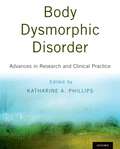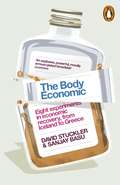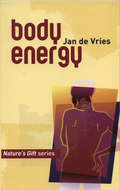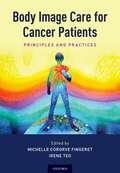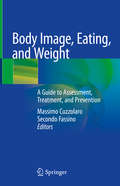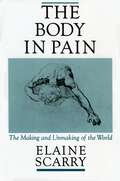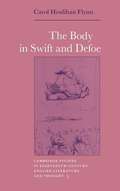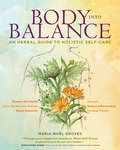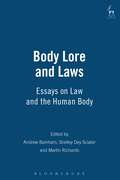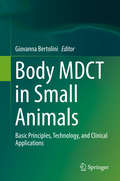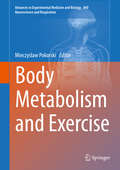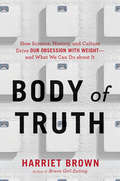- Table View
- List View
The Body Divided: Human Beings and Human 'Material' in Modern Medical History (The History of Medicine in Context)
by Sally WildeBodies and body parts of the dead have long been considered valuable material for use in medical science. Over time and in different places, they have been dissected, autopsied, investigated, harvested for research and therapeutic purposes, collected to turn into museum and other specimens, and then displayed, disposed of, and exchanged. This book examines the history of such activities, from the early nineteenth century through to the present, as they took place in hospitals, universities, workhouses, asylums and museums in England, Australia and elsewhere. Through a series of case studies, the volume reveals the changing scientific, economic and emotional value of corpses and their contested place in medical science.
The Body Divided: Human Beings and Human 'Material' in Modern Medical History (The History of Medicine in Context)
by Sally WildeBodies and body parts of the dead have long been considered valuable material for use in medical science. Over time and in different places, they have been dissected, autopsied, investigated, harvested for research and therapeutic purposes, collected to turn into museum and other specimens, and then displayed, disposed of, and exchanged. This book examines the history of such activities, from the early nineteenth century through to the present, as they took place in hospitals, universities, workhouses, asylums and museums in England, Australia and elsewhere. Through a series of case studies, the volume reveals the changing scientific, economic and emotional value of corpses and their contested place in medical science.
Body Dysmorphic Disorder: Advances in Research and Clinical Practice
by Katharine A. PhillipsThis landmark book is the first comprehensive edited volume on body dysmorphic disorder (BDD), a common and severe disorder. People with BDD are preoccupied with distressing or impairing preoccupations with non-existent or slight defects in their physical appearance. People with BDD think that they look ugly -- even monstrous -- although they look normal to others. BDD often derails sufferers' lives and can lead to suicide. BDD has been described around the world since the 1800s but was virtually unknown and unstudied until only several decades ago. Since then, research on BDD has dramatically increased understanding of this often-debilitating condition. Only recently, BDD was considered untreatable, but today, most sufferers can be successfully treated. This is the only book that provides comprehensive, in-depth, up-to-date information on BDD's clinical features, history, classification, epidemiology, morbidity, features in special populations, diagnosis and assessment, etiology and pathophysiology, treatment, and relationship to other disorders. Numerous chapters focus on cosmetic treatment, because it is frequently received but usually ineffective for BDD, which can lead to legal action and even violence toward treating clinicians. The book includes numerous clinical cases, which illustrate BDD's clinical features, its often-profound consequences, and recommended treatment approaches. This volume's contributors are the leading researchers and clinicians in this rapidly expanding field. Editor Katharine A. Phillips, head of the DSM-V committee on BDD, has done pioneering research on many aspects of this disorder, including its treatment. This book will be of interest to all clinicians who provide mental health treatment and to researchers in BDD, anxiety disorders, eating disorders, and other obsessive-compulsive and related disorders. It will be indispensable to surgeons, dermatologists, and other clinicians who provide cosmetic treatment. Students and trainees with an interest in psychology and mental health will also be interested in this book. This book fills a major gap in the literature by providing clinicians and researchers with cutting-edge, indispensable information on all aspects of BDD and its treatment.
Body Dysmorphic Disorder: Advances in Research and Clinical Practice
This landmark book is the first comprehensive edited volume on body dysmorphic disorder (BDD), a common and severe disorder. People with BDD are preoccupied with distressing or impairing preoccupations with non-existent or slight defects in their physical appearance. People with BDD think that they look ugly -- even monstrous -- although they look normal to others. BDD often derails sufferers' lives and can lead to suicide. BDD has been described around the world since the 1800s but was virtually unknown and unstudied until only several decades ago. Since then, research on BDD has dramatically increased understanding of this often-debilitating condition. Only recently, BDD was considered untreatable, but today, most sufferers can be successfully treated. This is the only book that provides comprehensive, in-depth, up-to-date information on BDD's clinical features, history, classification, epidemiology, morbidity, features in special populations, diagnosis and assessment, etiology and pathophysiology, treatment, and relationship to other disorders. Numerous chapters focus on cosmetic treatment, because it is frequently received but usually ineffective for BDD, which can lead to legal action and even violence toward treating clinicians. The book includes numerous clinical cases, which illustrate BDD's clinical features, its often-profound consequences, and recommended treatment approaches. This volume's contributors are the leading researchers and clinicians in this rapidly expanding field. Editor Katharine A. Phillips, head of the DSM-V committee on BDD, has done pioneering research on many aspects of this disorder, including its treatment. This book will be of interest to all clinicians who provide mental health treatment and to researchers in BDD, anxiety disorders, eating disorders, and other obsessive-compulsive and related disorders. It will be indispensable to surgeons, dermatologists, and other clinicians who provide cosmetic treatment. Students and trainees with an interest in psychology and mental health will also be interested in this book. This book fills a major gap in the literature by providing clinicians and researchers with cutting-edge, indispensable information on all aspects of BDD and its treatment.
The Body Economic: Eight experiments in economic recovery, from Iceland to Greece
by David Stuckler Sanjay BasuThe global financial crisis has had a seismic impact upon the wealth of nations. But we have little sense of how it affects one of the most fundamental issues of all: our physical and mental health.This highly significant new book, based on the authors' own groundbreaking research, looks at the daily lives of people affected by financial crisis, from the Great Depression of the 1930s, to post-communist Russia, to the US foreclosure crisis of the late 2000s. Why, it asks, did Sweden experience a fall in suicides during its banking crisis? What triggered a mosquito-borne epidemic in California in 2007? What caused 10 million Russian men to 'disappear' in the 1990s? Why is Greece experiencing rocketing HIV rates? And how did the health of Americans actually improve during the catastrophic crisis of the 1930s? The conclusions it draws are both surprising and compelling: remarkably, when faced with similar crises, the health of some societies - like Iceland - improves, while that of others, such as Greece, deteriorates. Even amid the worst economic disasters, negative public health effects are not inevitable: it's how communities respond to challenges of debt and market turmoil that counts. The Body Economic puts forward a radical proposition. Austerity, it argues, is seriously bad for your health. We can prevent financial crises from becoming epidemics, but to do so, we must acknowledge what the hard data tells us: that, throughout history, there is a causal link between the strength of a community's health and its social protection systems. Now and for generations to come, our commitment to the building of fairer, more equal societies will determine the health of our body economic.
Body Energy: A Complete Guide To Using The Major Forms Of Healing For Body, Mind And Spirit
by Jan De VriesBody Energy is the first book in Jan de Vries' outstanding new health series, Nature's Gift, and is intended to show how the body's energies can be used to combat ailments from headaches to spinal problems. Even the most healthy of us can benefit from an increase in energy; a physical and mental boost encouraged by attitude and action. In this book, Jan de Vries outlines, with the help of drawings and photographs, detailed exercises which may be used to increase body energy. He describes the harnessing of energy through the mind, eyes, hands, bones and muscles, as well as through nutrition. Body Energy is a triumph - available to us all.
Body Fat and Physical Fitness: Body Composition and Lipid Metabolism in Different Regimes of Physical Activity
by S. ParizkovaMan develops during phylogenesis and ontogenesis as an active creature and his most striking external manifestations include physical activity. From this ensue efforts to investigate the human organism with regard to its functional diagnosis mainly during activity, in relation to the level of that physical activity. The amount and qualitative aspect of physical activity is subject to some laws associated with the developmental stage, type of higher nervous activity, health, nutritional status, external environment inc!. social position, profession, hobbies, etc.; thus it is also one of the important ecological factors. During the period before the onset of technical civilization physical fitness and performance were essential prerequisites for survival and successful existence. At present and from the aspect of the perspective development of our civilization the importance of physical fitness is pushed into the background; nevertheless adequate physical activity level is even today an important prerequisite for normal function of the organism as a whole.
Body Fluid Management: From Physiology to Therapy
by Felice AgròThe administration of intravenous fluids is one of the most common and important therapeutic practices in the treatment of surgical, medical and critically ill patients. The international literature accordingly contains a vast number of works on fluid management, yet there is still confusion as to the best options in the various situations encountered in clinical practice.The purpose of this volume is to help the decision-making process by comparing different solution properties describing their indications, mechanisms of action and side-effects according to physiologic body water distribution, electrolytic and acid-base balance, and to clarify which products available on the market represent the best choice in different circumstances. The book opens by discussing in detail the concepts central to a sound understanding of abnormalities in fluid and electrolyte homeostasis and the effect of intravenous fluid administration. In the second part of the monograph, these concepts are used to explain the advantages and disadvantages of solutions available on the market in different clinical settings. Body Fluid Management: From Physiology to Therapy will serve as an invaluable decision-making guide, including for those who are not experts in the subject.
Body Image and Disfigurement Care (Routledge Essentials for Nurses)
by Robert NewellIntended for health care professionals working with patients who have suffered a threat to body image, whether from trauma, injury, disease, or the developmental process, Body Image and Disfigurement Care:*offers practical advice about care*critically appraises the existing knowledge-base*describes the different theoretical approaches to body image disturbance*puts forward a new model of what happens to people with disturbed body image.While written in an accessible style, this is not a superficial text; it presents practical skills which can be used in clinical settings and these skills are based on appropriate research evidence, Interactive exercises enable the student to consolidate their learning and improve their understanding of the patient's experience of a threat to body image. Body Image and Disfigurement Care provides a sound source of help and advice about an issue of growing importance in modern health.
Body Image and Disfigurement Care (Routledge Essentials for Nurses)
by Robert NewellIntended for health care professionals working with patients who have suffered a threat to body image, whether from trauma, injury, disease, or the developmental process, Body Image and Disfigurement Care:*offers practical advice about care*critically appraises the existing knowledge-base*describes the different theoretical approaches to body image disturbance*puts forward a new model of what happens to people with disturbed body image.While written in an accessible style, this is not a superficial text; it presents practical skills which can be used in clinical settings and these skills are based on appropriate research evidence, Interactive exercises enable the student to consolidate their learning and improve their understanding of the patient's experience of a threat to body image. Body Image and Disfigurement Care provides a sound source of help and advice about an issue of growing importance in modern health.
Body Image Care for Cancer Patients: Principles and Practice
by Michelle Cororve Fingeret and Irene TeoThis book is the first and only academic textbook of principles and practices of body image care for cancer patients, designed to target a multidisciplinary audience of healthcare care professionals engaged in the science and/or practice of psychosocial oncology internationally. Content is primarily geared toward mental health professionals or those involved in supportive care of cancer patients, but is broadly applicable to all members of the oncologic healthcare team. Best practices and models of body image care are reviewed and presented in such a manner as to be directly relevant to oncologists, psychiatrists, psychologists, nurses, social workers, rehabilitation specialists, speech and language pathologists, and other allied healthcare professionals. Body Image Care for Cancer Patients provides a 7omprehensive overview of available literature on body image outcomes with cancer populations, and integrates scientific findings from the general body image literature that can be applied to the oncology setting. Readers are provided with a comprehensive theoretical foundation along with practical recommendations for assessment tools and intervention approaches that can be utilized by a range of healthcare professionals. Case examples are incorporated throughout the textbook considering different aspects of disease and treatment, and are written from the perspective of different professional disciplines. This book will be relevant for emerging as well as established healthcare professionals internationally, and can be used in training and other educational settings. This book is unique as there is no current academic text focusing on advancing the science and practice of body image care for cancer patients. Other reference texts have broadly focused on reviewing body image theory and findings in the general population or across a broad spectrum of medical illness. The time has come for a more focused textbook specific to body image and cancer that can significantly benefit the field of oncology.
Body Image Care for Cancer Patients: Principles and Practice
This book is the first and only academic textbook of principles and practices of body image care for cancer patients, designed to target a multidisciplinary audience of healthcare care professionals engaged in the science and/or practice of psychosocial oncology internationally. Content is primarily geared toward mental health professionals or those involved in supportive care of cancer patients, but is broadly applicable to all members of the oncologic healthcare team. Best practices and models of body image care are reviewed and presented in such a manner as to be directly relevant to oncologists, psychiatrists, psychologists, nurses, social workers, rehabilitation specialists, speech and language pathologists, and other allied healthcare professionals. Body Image Care for Cancer Patients provides a 7omprehensive overview of available literature on body image outcomes with cancer populations, and integrates scientific findings from the general body image literature that can be applied to the oncology setting. Readers are provided with a comprehensive theoretical foundation along with practical recommendations for assessment tools and intervention approaches that can be utilized by a range of healthcare professionals. Case examples are incorporated throughout the textbook considering different aspects of disease and treatment, and are written from the perspective of different professional disciplines. This book will be relevant for emerging as well as established healthcare professionals internationally, and can be used in training and other educational settings. This book is unique as there is no current academic text focusing on advancing the science and practice of body image care for cancer patients. Other reference texts have broadly focused on reviewing body image theory and findings in the general population or across a broad spectrum of medical illness. The time has come for a more focused textbook specific to body image and cancer that can significantly benefit the field of oncology.
Body Image, Eating, and Weight: A Guide To Assessment, Treatment, And Prevention
by Massimo Cuzzolaro Secondo FassinoThis book equips readers with the knowledge required to improve diagnosis and treatment and to implement integrated prevention programs in patients with eating and weight disorders. It does so by providing a comprehensive, up-to-date review of research findings and theoretical assumptions concerning the interface and interactions between body image and such disorders as anorexia nervosa, bulimia nervosa, binge eating disorder, other specified feeding and eating disorders, orthorexia nervosa, overweight, and obesity. After consideration of issues of definition and classification, the opening part of the book examines the concept of body image from a variety of viewpoints. A series of chapters are then devoted to the assessment of the multidimensional construct “body image”, to dysmorphophobia/body dysmorphic disorder, and to muscle dysmorphia. The third part discusses body image in people suffering from different eating disorders and/or overweight or obesity, and two final chapters focus on body image in the integrated prevention of eating disorders and obesity, and cultural differences regarding body image. The book will be of interest to all health professionals who work in the fields of psychiatry, clinical psychology, eating disorders, obesity, body image, adolescence, public health, and prevention.
The Body in Balance: Humoral Medicines in Practice (Epistemologies of Healing #13)
by Peregrine Horden Elisabeth HsuFocusing on practice more than theory, this collection offers new perspectives for studying the so-called “humoral medical traditions,” as they have flourished around the globe during the last 2,000 years. Exploring notions of “balance” in medical cultures across Eurasia, Africa and the Americas, from antiquity to the present, the volume revisits “harmony” and “holism” as main characteristics of those traditions. It foregrounds a dynamic notion of balance and asks how balance is defined or conceptualized, by whom, for whom and in what circumstances. Balance need not connoteegalitarianism or equilibrium. Rather, it alludes to morals of self care exercised in place of excessiveness and indulgences after long periods of a life in dearth. As the moral becomes visceral, the question arises: what constitutes the visceral in a body that is in constant flux and flow? How far, and in what ways, are there fundamental properties or constituents in those bodies?
The Body in Everyday Life (The New Sociology)
by Sarah Nettleton Jonathan WatsonWe all have a body, but how does it impact upon our day to day life? This book sets out to explore how ordinary women, men and children talk about their bodies, through four central themes:-* physical and emotional bodies* illness and disability* gender* ageing.A coherent collection of such empirical research, The Body in Everyday Life provides an accessible introduction to the sociology of the body, a field previously dominated by theoretical or philosophical accounts.
The Body in Everyday Life (The New Sociology)
by Sarah Nettleton Jonathan WatsonWe all have a body, but how does it impact upon our day to day life? This book sets out to explore how ordinary women, men and children talk about their bodies, through four central themes:-* physical and emotional bodies* illness and disability* gender* ageing.A coherent collection of such empirical research, The Body in Everyday Life provides an accessible introduction to the sociology of the body, a field previously dominated by theoretical or philosophical accounts.
The Body in Medical Thought and Practice (Philosophy and Medicine #43)
by DrewLederIn the second half of the 20th century, the body has become a central theme of intellectual debate. How should we perceive the human body? Is it best understood biologically, experientially, culturally? How do social institutions exercise power over the body and determine norms of health and behavior? The answers arrived at by phenomenologists, social theorists, and feminists have radically challenged our cenventional notions of the body dating back to 17th century Cartesian thought. This is the first volume to systematically explore the range of contemporary thought concerning the body and draw out its crucial implications for medicine. Its authors suggest that many of the problems often found in modern medicine -- dehumanized treatment, overspecialization, neglect of the mind's healing resources -- are directly traceable to medicine's outmoded concepts of the body. New and exciting alternatives are proposed by some of the foremost physicians and philosophers working in the medical humanities today.
The Body in Pain: The Making and Unmaking of the World
by Elaine ScarryPart philosophical meditation, part cultural critique, The Body in Pain is a profoundly original study that has already stirred excitement in a wide range of intellectual circles. The book is an analysis of physical suffering and its relation to the numerous vocabularies and cultural forces--literary, political, philosophical, medical, religious--that confront it. Elaine Scarry bases her study on a wide range of sources: literature and art, medical case histories, documents on torture compiled by Amnesty International, legal transcripts of personal injury trials, and military and strategic writings by such figures as Clausewitz, Churchill, Liddell Hart, and Kissinger, She weaves these into her discussion with an eloquence, humanity, and insight that recall the writings of Hannah Arendt and Jean-Paul Sartre. Scarry begins with the fact of pain's inexpressibility. Not only is physical pain enormously difficult to describe in words--confronted with it, Virginia Woolf once noted, "language runs dry"--it also actively destroys language, reducing sufferers in the most extreme instances to an inarticulate state of cries and moans. Scarry analyzes the political ramifications of deliberately inflicted pain, specifically in the cases of torture and warfare, and shows how to be fictive. From these actions of "unmaking" Scarry turns finally to the actions of "making"--the examples of artistic and cultural creation that work against pain and the debased uses that are made of it. Challenging and inventive, The Body in Pain is landmark work that promises to spark widespread debate.
The Body in Swift and Defoe (PDF)
by Carol Houlihan FlynnThis original book takes a new look at problems surrounding the physical, material nature of the human body, in particular as represented in the works of Jonathan Swift and Daniel Defoe. It examines the role that literary invention (with its rhetorical and linguistic strategies) plays in expressing and exploring the problems of physicality, and deals with issues such as sexuality, cannibalism, scatology and the fear of contagion. Swift and Defoe are seen as writers confronting the essentially modern problem of what it is to be human in a rapidly developing consumer economy, where individual bodies, beset by poverty and disease, are felt to be threatened by the enveloping masses of urban crowds. In an eclectic synthesis of recent approaches, Carol Flynn works into her study the insights provided by biographical and psychoanalytic criticism, Marxism and social history, studies of eighteenth-century philosophy, and feminist readings.
Body into Balance: An Herbal Guide to Holistic Self-Care
by Maria Noel GrovesA highly accessible natural health guide to all the major body systems and their common imbalances, with in-depth advice on how to best use herbal medicine to support and nourish each system, address chronic health issues, and help achieve optimal health.
Body Lore and Laws: Essays on Law and the Human Body
by Andrew Bainham Shelley Day Sclater Martin RichardsThis book,the second produced by the Cambridge Socio-Legal Group, is a collection of essays on the subject of law and the human body. As the title suggests, bodies and body parts are not only subject to regulation through formal legal processes, but also the meanings attached to particular bodies, and the significance accorded to some body parts, are aspects ofbroader cultural processes. In short, bodies are subjected to both lore and laws. The contributors, all leading academics in the fields of Law, Sociology, Psychology, Feminism, Criminology, Biology and Genetics, respectively, offer a range of interdisciplinary papers that critically examine how bodies are constructed and regulated in law.The book is divided into two parts. Part one is concerned with 'Making Bodies' and includes papers relating to transactions in human gametes, cloning, court-ordered caesarean sections, testing for genetic risk, the patenting of human genes and the social policy implications of the growth in genetic information. Part two is concerned with 'Using and Abusing Bodies'. It contains chapters relating to sexualities, sexual orientation and the law, sex workers and their clients, domestic homicide, religious and cultural practices and other issues involving children's bodies, the ownership of the body and body parts and the legal and ethical issues surrounding euthanasia.
Body MDCT in Small Animals: Basic Principles, Technology, and Clinical Applications
by Giovanna BertoliniThis book is an up-to-date, technically detailed yet easy-to-read reference book on current clinical applications of MDCT in small animals. It has been designed to serve as the reference book for all MDCT-users, such as veterinary radiologists, imaging technicians, oncologists, surgeons, and non-radiologist clinicians. Individual chapters on novel clinically important topics include applications in endocrinology, oncology, trauma, and cardiovascular CT, as well as sections on organ-specific pathologies and their CT characteristics. The book will also cover main domains of CT, such as thorax and the trauma imaging. Anatomy, clinical aspects, pathology, and CT signs are integrated to provide the reader with the basis for interpretation of MDCT findings. Many excellent 2D multiplanar and 3D figures illustrating typical CT findings of various conditions will serve as a clinical reference for the reader.
Body Messages: The Quest For The Proteins Of Cellular Communication
by Giamila FantuzziWhether classified as regulators of inflammation, metabolism, or other functions, a distinctive set of molecules enables the body to convey information from one cell to another. Giamila Fantuzzi offers a primer on molecular mediators that coordinate complex bodily processes, and explores the consequences of their discovery for modern medicine.
Body Metabolism and Exercise (Advances in Experimental Medicine and Biology #840)
by Mieczyslaw PokorskiThe dynamics of body metabolism are changed in the disease process and interact with physical activity. The alteration of metabolism and its consequences raise the need for simple and reliable methods for assessment of body composition. The chapters aim to investigate various interacting components converging on metabolic changes in lung and muscle tissues taking into consideration the drug effects. The effects of exercise and nutritional status are dealt with at a great extent.
Body of Truth: How Science, History, and Culture Drive Our Obsession with Weight--and What We Can Do about It
by Harriet BrownOver the past twenty-five years, our quest for thinness has morphed into a relentless obsession with weight and body image. In our culture, "fat" has become a four-letter word. Or, as Lance Armstrong said to the wife of a former teammate, "I called you crazy. I called you a bitch. But I never called you fat." How did we get to this place where the worst insult you can hurl at someone is "fat"? Where women and girls (and increasingly men and boys) will diet, purge, overeat, undereat, and berate themselves and others, all in the name of being thin?As a science journalist, Harriet Brown has explored this collective longing and fixation from an objective perspective; as a mother, wife, and woman with "weight issues," she has struggled to understand it on a personal level. Now, in Body of Truth, Brown systematically unpacks what's been offered as "truth" about weight and health.Starting with the four biggest lies, Brown shows how research has been manipulated; how the medical profession is complicit in keeping us in the dark; how big pharma and big, empty promises equal big, big dollars; how much of what we know (or think we know) about health and weight is wrong. And how all of those affect all of us every day, whether we know it or not.The quest for health and wellness has never been more urgent, yet most of us continue to buy into fad diets and unattainable body ideals, unaware of the damage we're doing to ourselves. Through interviews, research, and her own experience, Brown not only gives us the real story on weight, health, and beauty, but also offers concrete suggestions for how each of us can sort through the lies and misconceptions and make peace with and for ourselves.

